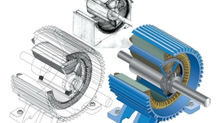5 Most Common Critical Power Distribution Topologies
Today’s mission-critical applications
In many of today’s mission-critical applications, ever-increasing reliability requirements are the norm. A critical part of this reliability is the reliability of the electric power distribution system for a given facility.
Among the most demanding applications is that of a data center, where the enduse equipment cannot tolerate even a momentary power outage and, further, even relatively minor disturbances in the power system can cause computer systems to re-boot, causing operational down-time
A full-scale utility failure, lasting for minutes or even hours, is therefore not tolerable for these types of systems. In fact, even the approximately10 seconds of outage required for transfer of the system to generator power is not an option in these types of systems, a concept that will be explored in greater depth below.
That no power system component can operate with 100% reliability is a well-known fact. Another fact is that the availability of utility power is less than 100% (typically 99-99.9%).
Therefore, the possibility of utility power and internal system component failure must be taken into account in the system design.
Topologies
The choice of power system distribution topology is the first line of defense against critical-load outages.
Secondary-Selective ‘Main-Tie-Main’ Arrangement
Main-Tie-Main’ topology
Ring Bus Arrangement
Primary Loop Arrangement
Composite Primary Loop/Secondary Selective Arrangement
1. Secondary-Selective ‘Main-Tie-Main’ Arrangement
In the context of automatic transfers, the most common arrangement is the secondary selective or “main-tie-main” arrangement. One implementation of this arrangement is as shown in Figure 1:

In this arrangement, there are two busses, each of which serves approximately 50% of the load, but is sized to carry the entire load. In Figure 1, this means that each transformer, secondary main circuit breaker, and secondary equipment bus is sized to carry the entire load.
Should a transformer fail, the entire load may be transferred to the other transformer and its associated secondary bus via the bus tie circuit breaker.
2. Main-Tie-Main’ topology
There are many variations on previous arrangement. In critical-power applications the most common variation is to use two bus tie circuit breakers, and have the two secondary busses separated into two different pieces of equipment. Another variation is the main-main arrangement, which omits the bus tie circuit breaker and simply has the two secondary busses connected all the time.
In this arrangement, one power source normally carriesthe entire load, and the other is strictly a standby power source should the normal source fail. In this way the main-main arrangement is analogous to an automatic transfer switch (ATS).
Both of these variations are shown in Figure 2.

Figure 2 – Variations on the ‘Main-Tie-Main’ topology a.) ‘Main-Tie-Tie-Main’ b.) ‘Main-Main’
Other arrangements exist, however none are as popular in the critical-power distribution environment as the secondary-selective “main-tie-main” and its variants.
It should be noted that the main-tie-main topology is also commonly used at the medium-voltage level.
3. Ring Bus Arrangement
One other arrangement, however, has been used with great success is the ring bus, as illustrated in Figure 3:

Figure 3 – Ring Bus Arrangement
The ring bus arrangement allows the flexibility of supplying multiple loads using multiple busses. It is most often used at the medium-voltage level, and usually in a “closed loop” arrangement with all of the bus tie circuit breakers closed.
4. Primary Loop Arrangement
A variation on the ring-bus is the primary loop arrangement shown in Figure 4:

Figure 4 – Primary Loop Arrangement
A primary loop arrangement typically uses load-interrupter switches for switching on the loop, and is more economically justifiable than a full ring-bus system. Typically, the loop is operated in an “open-loop” arrangement, but still gives the ability to supply all loads from either side of the loop.
5. Composite Primary Loop/Secondary Selective Arrangement
Extreme flexibility and increased reliability are obtained by combining topologies. An example of this is the composite primary loop/secondary-selective arrangement shown in Figure 5.
Here, multiple failure contingencies are addressed ina generally economically-feasible manner.

Figure 5 – Composite Primary Loop/Secondary Selective Arrangement
Reference: Critical-Power Automatic Transfer Systems – Design and Application / Bill Brown, P.E., Jay Guditis, Square D Critical Power Competency Center / EEP































